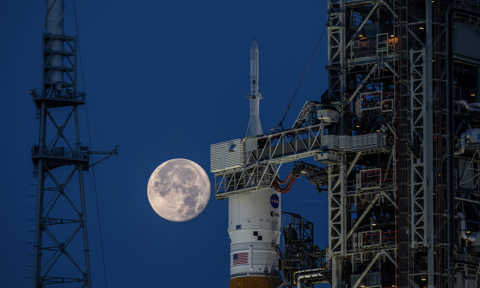
NASA is all set to launch its most powerful rocket yet and it carries some unique surprises.
The Artemis I mission will take off from Earth on August 29, 2022, to set off on a journey around the moon. However, no human being will be onboard the Orion capsule attached to the mission. But the spaceship won’t be empty.
MORE: NASA Released Images From The James Webb Space Telescope
The space agency’s newest launch system is its first major step toward getting humans back to the surface of the Moon after 1972. The new Space Launch System’s mega-rocket will take a trip around the moon with three special mannequins onboard, along with some familiar faces as zero gravity indicators, and artefacts from Earth.
ARTEMIS I UPDATE: The rollout of @NASA_SLS & @NASA_Orion to Launch Pad 39B has now moved up to tomorrow, the evening of Aug. 16, ahead of the targeted Aug. 29 launch. Stay tuned for more information as well as ongoing coverage. pic.twitter.com/28kRuwB4pN
— NASA's Exploration Ground Systems (@NASAGroundSys) August 15, 2022
Artemis I mission will take this motley crew of passengers around the moon, farther than any spacecraft built for humans has ever flown, before heading for a splashdown in the Pacific Ocean.
The mannequins on board are going to serve a crucial purpose. The first one, strapped to the commander’s seat, is named Commander Moonikin Campos, as a tribute to Arturo Campos, an electrical engineer who played a crucial role in getting Apollo 13 back to Earth safely.
READ: A Massive Sunspot Has Doubled In Size And Here’s Why It’s Alarming
Commander Moonikin will have several sensors on and around him that will record the acceleration and vibration generated throughout the mission. The mannequin will also be equipped with radiation sensors that will measure the radiation exposure on the mission. The two other mannequins, Helga and Zohar, will have torsos made of materials that mimic a woman’s soft tissue, organs, and bones, and will also be equipped with special sensors that measure how the bodies react to the radiation. It will also provide data that would enable NASA to send the first woman to the Moon in the future Artemis missions.
Commander Campos here, and happy to be going! I’m equipped with radiation sensors, and I will have more sensors under my headrest and behind my seat to measure the acceleration and vibrations future @NASA_Astronauts could experience on their missions to the Moon. pic.twitter.com/4meNQIchkN
— NASA Artemis (@NASAArtemis) July 8, 2022
“It’s critical for us to get data from the Artemis I manikin to ensure all of the newly designed systems, coupled with an energy dampening system that the seats are mounted on, integrate together and provide the protection crew members will need in preparation for our first crewed mission on Artemis II,” said Jason Hutt, NASA lead for Orion Crew Systems Integration, in a statement last year.
The data collected from this mission will ascertain the measures needed to safeguard the crew onboard Artemis II mission in 2024, that will fly around the moon, and Artemis III which will have astronauts eventually land on the surface of the Moon.
“When it comes to biological effects, different organs have different susceptibility to space radiation. Understanding the impact is very important for successful and sustainable human space exploration efforts,” said Ramona Gaza, science team lead at NASA’s Johnson Space Center in Houston, at a recent news briefing.
Excited about #Artemis I? 🐏 The latest blog post from our specially trained woolly astronaut @shaunthesheep tells how he 'got in a spin' about being assigned a seat on this historic mission to the #Moon! 👉 https://t.co/SZ6yk2XS41pic.twitter.com/4iBcTYiIAx
— ESA (@esa) August 16, 2022
Aside from these mannequins, the mission will also carry several familiar cartoon figures in their plush forms, including Shaun from British show Shaun the Sheep and Snoopy from Peanuts. These will act as Zero Gravity Indicators, that are small items aboard a spacecraft that serve as a visual indicator that it has entered zero gravity.
Four Lego Minifigures, from the company’s Build To Launch series in collaboration with NASA, will also be on board along with the unique crew.
#DYK Lego minifigures Command Pilot Kate and Mission Specialist Kyle will be aboard the historic #Artemis I flight? Help @LEGO_Education countdown to launch and join us at #KennedySpaceCenter August 26-29 for an out of this world experience! #BuildToLaunch#LegoEducationpic.twitter.com/a9SlvMdL99
— Kennedy Space Center Visitor Complex (@ExploreSpaceKSC) August 17, 2022
“Each minifigure represents a real-life counterpart, such as a command pilot Kate and mission specialist Kyle, to help students better understand the diverse roles, backgrounds, and skillsets within the Artemis I team,” Lego Education said in a statement in November of last year.
Through these missions, NASA is attempting to set up a permanent base in the Moon’s orbit and on the surface. This is why the space organisation is sending plants and seeds along with this mission to test how they will fare in deep space. According to a statement by Sharmila Bhattacharya, NASA program scientist for space biology, this will help understand how Earthly biological systems can fare in deep space conditions.
“Gathering information like this and analyzing it after flight will eventually help us paint the full picture of how we can help humans thrive in deep space,” Bhattacharya added.
The mission’s official Flight Kit will also carry about 50kgs of mementoes, including artefacts from previous space missions, and objects of cultural significance.





